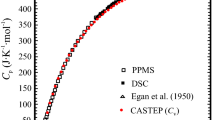Abstract
The heat capacity (C P) of a natural sample of calcite (CaCO3) has been measured from 350 to 775 K by differential scanning calorimetry (DSC). Heat capacities determined for a powdered sample and a single-crystal disc are in close agreement and have a total uncertainty of ±1 percent. The following equation for the heat capacity of calcite from 298 to 775 K was fit by least squares to the experimental data and constrained to join smoothly with the low-temperature heat capacity data of Staveley and Linford (1969) (C P in J mol−1 K−1, T in K):
Combining this equation with the S 0298 value from Staveley and Linford (1969), entropies for calcite are calculated and presented to 775 K. A simple method of extrapolating the heat capacity function of calcite above 775 K is presented. This method provides accurate entropies of calcite for high-temperature thermodynamic calculations, as evidenced by calculation of the equilibrium: CaCO3 (s)=CaO(s)+CO2 (s).
Similar content being viewed by others
References
Anderson, CT (1934) The heat capacities at low temperatures of the alkaline earth carbonates. J Am Chem Soc 56:340–342
Appleman, DE, Evans HT (1973) Job 9214: Indexing and least squares refinement of powder diffraction data. Natl Tech Inf. Serv., U.S. Dept. Commerce, Springfield, Virginia, Document PB 216188
Baker EH (1962) The calcium oxide-carbon dioxide system in the pressure range 1–300 atmospheres. J Chem Soc 464–470
Denbigh K (1971) The principles of chemical equilibrium. Cambridge University Press, New York
Ditmars DA, Douglas TB (1971) Measurement of the relative enthalpy of pure α-Al2O3 (NBS heat capacity and enthalpy standard reference material no. 720) from 273 to 1,173 K. Natl Bur Stand J Res 75A:401–420
Gronow HE von, Schwiete HE (1933) Die spezifischen Wärmen von CaO, Al2O3, CaO·Al2O3, 3CaO·Al2O3, 2CaO·SiO2, 3CaO·SiO2, und 2CaO·Al2O3·SiO2 von 20 bis 1500 °C. Z Anorg Allg Chem 216:185–195
Haas JL Jr, Fisher, JR (1976) Simultaneous evaluation and correlation of thermodynamic data. Am J Sci 276:525–545
Jacobs GK (1981) Ph. D. Dissertation, The Pennsylvania State University, University Park, PA, USA
Kobayashi K (1950) The heat capacities of inorganic substances at high temperatures. Part 1. The heat capacity of silver chloride. Sci Rep Tohoku Univ 34:112–119
Kobayashi K (1951) The heat capacities of inorganic substances at high temperatures. Part III. The heat capacity of synthetic calcite (calcium carbonate). Sci Rep Tohoku Univ 35:103–110
Krupka KM, Robie RA, Hemingway BS (1979) Higher-temperature heat capacities of corundum, periclase, anorthite, CaAl2Si2O8 glass, muscovite, pyrophyllite, K AlSi3O8 glass, grossular, and NaAlSi3O8 glass. Am Mineral 64:86–101
Lander JJ (1949) Polymorphism and anion rotational disorder in the alkaline earth carbonates. J Chem Phys 17:892–901
Magnus A (1913) Messung spezifischer Wärme des Kohlenstuffs, Silizium, und Siliziumkarbids bei hohen Temperaturen. Phys Z 14:5–11
McAdie HH, Garn PD, Menis O (1972) Standard reference materials: selection of differential thermal analysis temperature standards through a cooperative study (SRM 758, 759, 760). Natl Bur Stand Spec Publ 260–40
Mirwald PW (1979) The electrical conductivity of calcite between 300° and 1,200°C at a CO2 pressure of 40 bars. Phys Chem Minerals 4:291–297
Mraw SC, Naas DF (1979) The measurement of accurate heat capacities by differential scanning calorimetry. Comparison of d.s.c. results on pyrite (100 to 800 K) with literature values from precision adiabatic calorimetry. J Chem Thermodyn 11:567–584
O'Neill MJ (1966) Measurement of specific heat functions by differential scanning calorimetry. Anal Chem 38:1331–1336
O'Neill MJ, Fyans RL (1971) Design of differential scanning calorimeters and the performance of a new system. Paper presented at the Eastern Analytical Symposium in New York, New York
Robie RA, Hemingway BS, Fischer JR (1978) Thermodynamic properties of minerals and related substances at 298.15K and 1 bar (105 Pascals) pressure and at higher temperatures. Geol Surv Bull 1452, U.S. Government printing office, Washington, D.C.
Simon F, Swain RC (1935) Untersuchungen über die spezifischen Wärme bei tiefen Temperaturen. Z Phys Chem 28B:189–198
Smyth FH, Adams LH (1923) The system calcium oxide-carbon dioxide. J Am Chem Soc 45:1167–1184
Staveley LAK, Linford RG (1969) The heat capacity and entropy of calcite and aragonite, and their interpretation. J Chem Thermodyn 1:1–11
Author information
Authors and Affiliations
Rights and permissions
About this article
Cite this article
Jacobs, G.K., Kerrick, D.M. & Krupka, K.M. The high-temperature heat capacity of natural calcite (CaCO3). Phys Chem Minerals 7, 55–59 (1981). https://doi.org/10.1007/BF00309451
Received:
Issue Date:
DOI: https://doi.org/10.1007/BF00309451




